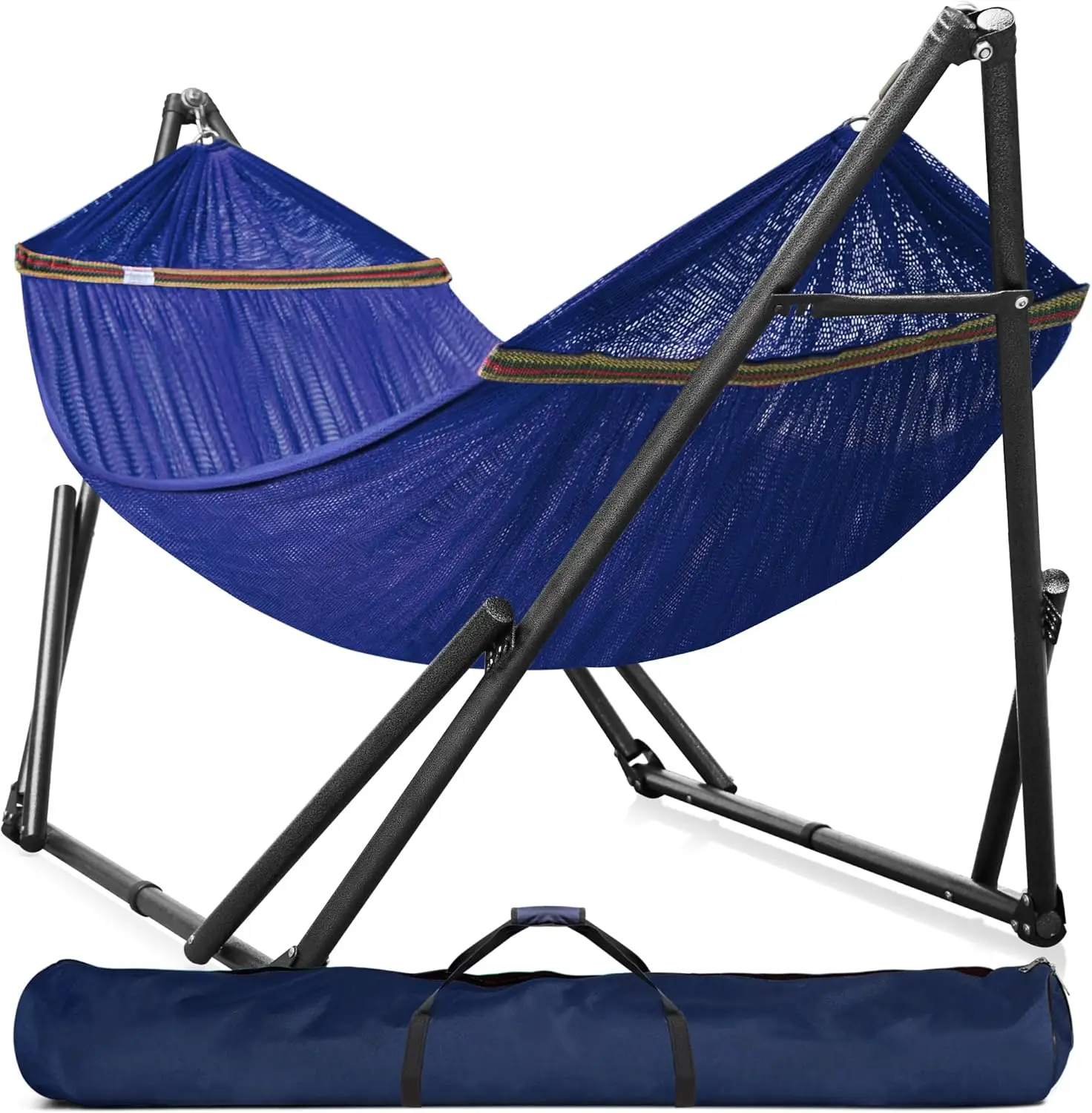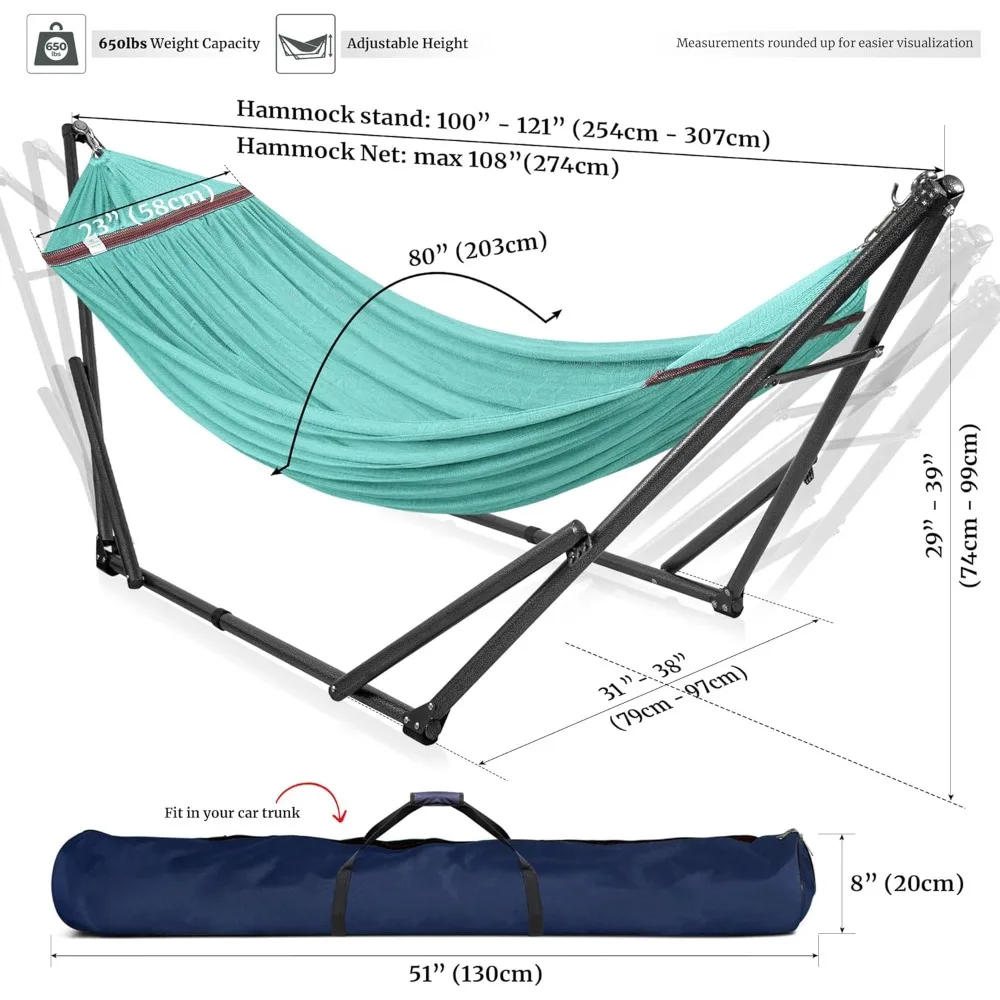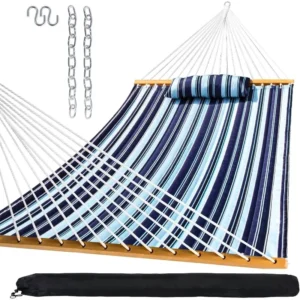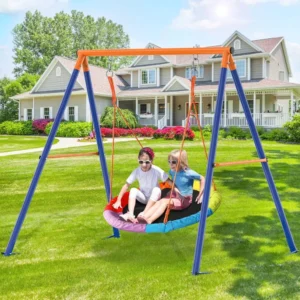Understanding the Different Types of Two-Person Hammock Systems
When planning a space for two people to hammock together, the first thing to understand is that not all “double” hammocks are truly designed for two people to sleep in comfortably. This distinction is crucial for proper space planning.
The main types of two-person hammock systems include:
Wide gathered-end doubles: These are essentially wider versions of single hammocks (typically 6-7 feet wide compared to 4-5 feet for singles). Despite being called “doubles,” they often work better for one person with extra space than for two sleepers.
Hammocks with spreader bars: These maintain a flatter, more stable surface using wooden or metal bars at each end, offering more space separation between occupants.
Integrated two-person systems: Purpose-built for two sleepers with features like divided sleeping areas, central stabilizing elements, or specialized geometries to prevent rolling together.
Side-by-side setups: Two separate hammocks hung near each other, either sharing trees or using separate anchor points altogether.
Each configuration dramatically affects the space needed. For instance, true two-person hammock systems require careful planning for weight distribution and anchor point placement, while side-by-side setups need consideration for multiple trees or posts.
Understanding which type fits your needs will determine everything from the number of trees needed to the overall footprint required. Our premium double two-person hammock sets come in various configurations to match different space requirements.
Essential Space Factors for All Two-Person Hammock Setups
Regardless of which hammock system you choose, certain universal principles apply when planning space for a two-person setup:
Anchor point distance: The horizontal space between trees, posts, or stand attachments must accommodate both the hammock length and proper sag for comfort.
Anchor point height: Typically needs to be 5-6 feet (1.5-1.8 m) from the ground, with sufficient strength to support double the weight.
Optimal hang angle: The industry-standard 30-degree angle from horizontal becomes even more critical with two people, as improper angles create uncomfortable pressure points.
Weight capacity: Two adults require stronger anchor points and suspension systems than single setups, affecting minimum tree diameter and stand specifications.
Clearance requirements: You’ll need:
- 12-18 inches (30-45 cm) ground clearance to avoid cold spots and ground contact when weighted
- 24-36 inches (60-90 cm) side clearance for comfortable entry/exit
- 24 inches (60 cm) minimum overhead clearance (more if using tarps)
Understanding how wide a 2-person hammock should be helps determine these space requirements. The standard formula suggests that the distance between anchor points should be about 80-85% of the total hammock length to create proper sag.
Space Requirements for Wide “Double” Gathered-End Hammocks
Wide gathered-end hammocks, commonly marketed as “doubles,” typically measure 6-7 feet (1.8-2.1 m) wide and 9-11 feet (2.7-3.4 m) long. Despite the name, these are often better for one person to lounge comfortably than for two people to sleep through the night.
For proper spacing with these hammocks, use the 90% rule: the distance between anchor points should be approximately 90% of the hammock’s total length. For example:
- An 11-foot (3.4 m) double hammock would need roughly 10 feet (3 m) between anchor points
- A 9-foot (2.7 m) hammock would need about 8 feet (2.4 m) between trees
When two people occupy these hammocks, additional considerations apply:
- The combined weight causes more sag, requiring higher hanging points
- The infamous “roll-together effect” becomes pronounced as both people naturally slide to the center
- The practical footprint including access space becomes approximately 12×7 feet (3.7×2.1 m)
For maximum comfort and stability, our heavy duty hammock sets provide enhanced support for the combined weight of two adults, reducing excessive sag while maintaining comfort.
Space Needs for Hammocks with Spreader Bars
Hammocks with spreader bars require a completely different spatial approach compared to gathered-end models. These hammocks maintain a flatter, more stable surface that can better accommodate two people side by side.
Key space considerations include:
- Anchor distance: Equal to or slightly more than the total hammock length (typically 12-13 feet or 3.7-4 m)
- Suspension height: Lower than gathered-end hammocks, usually 4-5 feet (1.2-1.5 m) from the ground
- Stability zone: Requires 2-3 feet (0.6-0.9 m) additional clearance on all sides to account for some movement
For example, a 13-foot (4 m) spreader bar hammock typically needs:
* Anchor points at least 13 feet (4 m) apart
* Mounting height of 4-5 feet (1.2-1.5 m)
* Total footprint of approximately 16×7 feet (4.9×2.1 m) including the stability zone
Spreader bar designs distribute weight more evenly, reducing the tendency to roll together, but they require more rigid mounting points. Our spreader bar hammock sets are engineered to provide the stability needed for two people while maintaining the proper space requirements.
Layout Options for Integrated Two-Person Hammock Systems
Specialized two-person hammock systems often feature innovative designs to solve the “roll-together” problem. These include triangular or geometric setups requiring three anchor points instead of the traditional two.
Space requirements for these integrated systems vary by design:
- Three-point anchored systems (like Tentsile):
- Require three strong anchor points forming a triangle
- Typical spacing of 15-20 feet (4.6-6.1 m) between each anchor point
- Minimum height of 4-5 feet (1.2-1.5 m) from the ground
Total footprint of approximately 225-400 square feet (21-37 square meters)
V-shaped or T-shaped configurations:
- Often use one central anchor point with two outer points
- Spacing of 10-15 feet (3-4.6 m) from center to each outer point
- Height requirements typically 5-6 feet (1.5-1.8 m)
- Allow separate but adjacent sleeping areas
These specialized systems excel at creating the most comfortable hammock setup for two people by eliminating the roll-together effect. However, they require more complex space planning and stronger anchor points due to the unique tension distribution.
The benefit of these systems is that they create separate sleeping surfaces while maintaining proximity—perfect for couples who want to sleep close without compromising comfort.
Configuring Two Single Hammocks Side-by-Side
Many experienced hammockers find that setting up two separate hammocks side-by-side provides the best sleep quality while still allowing for proximity. These configurations have their own space requirements:
- Four-tree configuration (two pairs):
- Each hammock needs its own pair of trees/posts
- Minimum spacing of 3-4 feet (0.9-1.2 m) between hammocks
- Traditional spacing for each individual hammock (9-12 feet or 2.7-3.7 m between trees)
Total footprint: approximately 12×10 feet (3.7×3 m) minimum
Three-tree V-configuration:
- Uses one shared center tree and two outer trees
- Center tree needs to be sturdier (at least 8 inches or 20 cm diameter)
- Hammocks form a V-shape with a 90-120 degree angle
Requires approximately 15×15 feet (4.6×4.6 m) of space
Stacked/bunk configurations:
- One hammock hung higher than the other
- Vertical separation of 2-3 feet (0.6-0.9 m)
- Uses the same trees but different height anchor points
- Smaller footprint but requires taller, sturdier trees
When considering whether two-person hammocks are worth it compared to side-by-side singles, many campers prefer this arrangement despite the additional space needs, as it provides optimal comfort with the intimacy of proximity.
Space Planning for Two-Person Hammock Stands
For locations without suitable trees, hammock stands offer a reliable alternative. Two-person hammock stands have specific space requirements:
- Standard free-standing two-person stands:
- Footprint: 12-15 feet long × 4-5 feet wide (3.7-4.6 m × 1.2-1.5 m)
- Clearance zone: Add 2 feet (0.6 m) on all sides for access
Total space needed: approximately 16-19 feet × 8-9 feet (4.9-5.8 m × 2.4-2.7 m)
Portable stands:
- Generally smaller footprint but less stability
- Typically 10-12 feet long × 4 feet wide (3-3.7 m × 1.2 m)
Need flat, level ground for safe use
Permanent stands:
- Can be larger and more stable
- Often incorporate features like canopies or storage
- May require 15-20 feet × 6-8 feet (4.6-6.1 m × 1.8-2.4 m)
The ultimate guide to heavy duty hammock stands provides deeper insights into stands capable of supporting two adults comfortably. Key considerations include ensuring adequate weight capacity (minimum 450-600 pounds or 204-272 kg) and proper stability to prevent tipping when two people enter or exit.

Calculating the Perfect Hang: Tools and Formulas
Achieving the perfect hang for a two-person setup requires careful calculations:
- The 30-degree rule: For optimal comfort, suspension straps should form approximately a 30-degree angle with the horizontal
- Sit height formula: For two people, aim for sit height (lowest point) = combined weight in pounds ÷ 100 + 6 inches
(For metric: combined weight in kg ÷ 45 + 15 cm) - Ridge line length: For gathered-end hammocks, a structural ridgeline should be 83% of the hammock length to ensure consistent sag
Step-by-step calculation example:
1. Combined weight: 350 lbs (159 kg)
2. Ideal sit height: (350 ÷ 100) + 6 = 9.5 inches (24 cm) from the ground
3. For an 11-foot (3.4 m) hammock:
– Ridgeline length: 11 × 0.83 = 9.13 feet (2.8 m)
– Hang points: approximately 10 feet (3 m) apart
– Hang height: about 5 feet (1.5 m) high
Several online hammock calculators can help with these calculations, though you’ll need to input the combined weight for best two-person hammocks for couples rather than individual weights.
Planning for Weather Protection: Tarp and Bug Net Space Requirements
Weather protection for two-person setups requires larger tarps and bug nets than single setups:
- Rain tarp sizing:
- Length: Hammock length + 2-3 feet (0.6-0.9 m) at each end
- Width: Hammock width + 3-4 feet (0.9-1.2 m) total
For a standard double hammock, aim for at least a 12×10 foot (3.7×3 m) tarp
Tarp ridgeline placement:
- Height: 12-18 inches (30-45 cm) above the hammock suspension
Length: 2-3 feet (0.6-0.9 m) longer than the hammock suspension
Bug net considerations:
- Specialized two-person bug nets are wider and taller
- Allow 8-12 inches (20-30 cm) of additional width beyond the hammock edges
- Ensure 18-24 inches (45-60 cm) of height for comfortable movement inside
Winter setups may require additional space for underquilts or insulation systems. Our camping hammock sets with bug nets include properly sized protection for two-person setups, ensuring complete coverage without unnecessary weight or bulk.
Finding the Perfect Spot: Site Assessment Guide
When selecting a location for a two-person hammock setup, use this checklist:
- Tree/anchor point assessment:
- Minimum diameter: 8 inches (20 cm) for supporting two adults
- Health check: No dead branches, disease, or visible damage
Bark type: Avoid trees with very thin or fragile bark
Distance measurement techniques:
- Use a 12-foot (3.7 m) piece of paracord as a quick measuring tool
- Count your steps (average stride is approximately 2.5 feet or 76 cm)
Use the wingspan method (fingertip to fingertip equals approximate height)
Ground condition evaluation:
- Check for hazards like sharp rocks, roots, or drainage channels
- Confirm flat area beneath for gear storage
Look for slight slope to prevent pooling water in case of rain
Overhead safety check:
- Look up for dead branches (“widow makers”) that could fall
- Check clearance for tarp installation
- Identify potential hazards like wasp nests or poison ivy on trees
Finding the best indoor and outdoor hammock locations requires attention to both safety and comfort factors. When ideal spacing isn’t available, consider using tree-friendly extension straps to reach more distant anchor points.
Common Space-Related Challenges for Two-Person Hammocking
Two-person hammocking presents unique spatial challenges:
- Limited anchor options solution:
- Use longer suspension straps (up to 15 feet or 4.6 m per side)
- Consider portable hammock stands as backup
Employ creative anchor systems like tripods for areas with only one tree
Managing the “roll-together” effect:
- Add a structural divider (foam noodle or stuff sack)
- Use a hammock designed with a center ridge or divider
Consider slightly offset hanging points (one end slightly higher)
Asymmetrical weight distribution fixes:
- Heavier person should hang their side with slightly more sag
- Use different thickness suspension for each side
Adjust hang angles to compensate (steeper angle for heavier person)
Uneven anchor heights:
- Calculate suspension length differences to achieve balanced sag
- Use adjustable suspension systems like whoopie slings
- Create an artificial high point using a temporary post
These practical solutions help overcome common space limitations while maintaining comfort for both hammockers.

Does a Two-Person Hammock Setup Really Save Space Compared to a Tent?
When comparing two-person hammock systems to tents, space considerations vary:
- Direct footprint comparison:
- Standard 2-person tent: 7×5 feet (2.1×1.5 m) footprint + guy lines
- Two-person hammock system: 12×5 feet (3.7×1.5 m) minimum between trees
Winner depends on configuration and accessories
Vertical space utilization:
- Hammocks use vertical space more efficiently
- No need for completely flat ground
Can set up over rough terrain, rocks, or slight slopes
Site selection flexibility:
- Tents require flat, clear ground
- Hammocks need appropriate anchor points
Each has advantages in different environments
Weather considerations:
- Hammock systems with full tarps can require more horizontal space
- Tents have more concentrated footprints but need additional clearance for stakes
While hammocks may have a larger linear footprint, their ability to utilize space over obstacles and uneven ground often makes them more space-efficient in wooded areas.
What Additional Features Impact the Space Needed for Two-Person Hammocks?
Special features in two-person hammocks can significantly affect space requirements:
Asymmetric designs:
These hammocks have diagonal sleeping positions, requiring wider spacing between trees (typically 1-2 feet or 30-60 cm more than symmetric models).Bridge hammocks:
Featuring spreader bars at head and foot, these need exactly their stated length in distance between anchor points, with minimal flexibility.Gear storage systems:
Under-hammock storage solutions need 6-12 inches (15-30 cm) of additional ground clearance, while gear hammocks or shelves require separate suspension points.Entry/exit mechanisms:
Side-entry designs need more clearance along the sides (about 3 feet or 0.9 m), while end-entry models need more space at the ends.Stabilization systems:
Pole systems, spreader bars, or tensioners require additional clearance for setup and proper functioning.
Taming wobble in double hammock stands becomes particularly important when two people are sharing the space, as movement from one person can disturb the other without proper stabilization.
Camping Hammock Sets with Bug Net, Ultralight Camping Hammock Sets
$139.72 Select options This product has multiple variants. The options may be chosen on the product pageClassic Wooden Stand Hammock Sets, Heavy Duty Hammock Sets
$1,061.68 Select options This product has multiple variants. The options may be chosen on the product pageHammock Sets with Canopy, Heavy Duty Hammock Sets
$286.31 Select options This product has multiple variants. The options may be chosen on the product pageDouble / Two Person Hammock Sets, Rope Hammock Sets
Double Traditional Cotton Rope Hammock with Extension Chains – 450 lbs Capacity for Backyard & Patio$292.98 Select options This product has multiple variants. The options may be chosen on the product pageFolding Hammock Sets, Quick Setup Hammock Sets
Price range: $305.52 through $583.27 Select options This product has multiple variants. The options may be chosen on the product page
Premium Two-Person Hammock Setup Considerations
High-end two-person hammock systems offer solutions to common challenges, but require specific space planning:
- Luxury two-person designs:
- Wider dimensions (often 7-8 feet or 2.1-2.4 m)
- Higher weight capacity requiring stronger anchors
More sophisticated suspension systems
Premium stand requirements:
- Larger footprints (15-18 feet or 4.6-5.5 m length)
- Heavier, more stable bases
Often include built-in canopies or shade structures adding 2-3 feet (0.6-0.9 m) to height
Enhanced comfort features affecting space:
- Memory foam padded surfaces requiring less sag
- Multi-layer systems needing more vertical clearance
Integrated canopies needing additional overhead space
Roll-prevention in premium models:
- Specialized tensioning systems
- Center ridges or dividers
- Custom geometries requiring specific hanging techniques
Outside Luxe’s premium hammocks incorporate many of these features, with two-person hammock fabrics offering superior comfort and durability while requiring appropriate space for optimal performance.
How Much Space Do You Need for Group Hammocking?
When setting up multiple two-person hammocks for groups or families, efficient layout becomes crucial:
- Star or hub-and-spoke layout:
- Uses central strong trees/posts with hammocks radiating outward
- Requires minimum 20×20 foot (6.1×6.1 m) clearing
Creates natural social space in the center
Parallel arrangement:
- All hammocks running same direction
- Minimum 4 feet (1.2 m) between each setup
Good for narrow but long spaces like trail corridors
Stacked triangular arrangement:
- Hammocks at different heights sharing anchor points
- Requires very strong trees/posts
Maximizes limited anchor points
Community tarp considerations:
- Large rectangular or hexagonal tarps covering multiple hammocks
- Needs center pole or high central anchor point
- Typically 15×15 feet (4.6×4.6 m) minimum
These configurations can help maximize limited space while creating communal relaxation areas for families or friend groups.

Total Space: Beyond the Hammocks
Creating a complete two-person hammock retreat requires thinking beyond just the hammock footprint:
- Complete site layout considerations:
- Allow 3-4 feet (0.9-1.2 m) clearance around hammocks for easy movement
- Plan for morning sun/afternoon shade positioning
Consider prevailing wind direction for tarp setup
Living space additions:
- Seating area: 3×3 feet (0.9×0.9 m) per person minimum
- Cooking space: 3×4 feet (0.9×1.2 m) if applicable
Gear storage: 2×3 feet (0.6×0.9 m) protected area
Experience enhancement elements:
- Privacy screens or natural barriers
- Lighting considerations for evening relaxation
- View orientation for scenic locations
For maximum flexibility and placement options, consider our portable hammocks with stands that create a self-contained relaxation environment independent of natural anchor points.
When planning your total space, remember that the goal is creating a comfortable environment that balances practicality with the peaceful ambiance that makes hammocking so appealing. With proper measurements and layout planning, your two-person hammock setup can become the perfect outdoor retreat.







